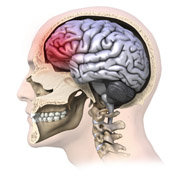Research and Innovation, UNL Office of

Center for Brain, Biology, and Behavior: Faculty Publications
Document Type
Article
Date of this Version
4-4-2013
Citation
2012 Elsevier B.V. All rights reserved.
Abstract
In this study we focused on direct comparison between the spatial distributions of activation detected by functional magnetic resonance imaging (fMRI) and localization of sources detected by magnetoencephalography (MEG) during identical language tasks. We examined the spatial concordance between MEG and fMRI results in 16 adolescents performing a three-phase verb generation task that involves repeating the auditorily presented concrete noun and generating verbs either overtly or covertly in response to the auditorily presented noun. MEG analysis was completed using a synthetic aperture magnetometry (SAM) technique, while the fMRI data were analyzed using the general linear model approach with random-effects. To quantify the agreement between the two modalities, we implemented voxel-wise concordance correlation coefficient (CCC) and identified the left inferior frontal gyrus and the bilateral motor cortex with high CCC values. At the group level, MEG and fMRI data showed spatial convergence in the left inferior frontal gyrus for covert or overt generation versus overt repetition, and the bilateral motor cortex when overt generation versus covert generation. These findings demonstrate the utility of the CCC as a quantitative measure of spatial convergence between two neuroimaging techniques.
Included in
Behavior and Behavior Mechanisms Commons, Nervous System Commons, Other Analytical, Diagnostic and Therapeutic Techniques and Equipment Commons, Other Neuroscience and Neurobiology Commons, Other Psychiatry and Psychology Commons, Rehabilitation and Therapy Commons, Sports Sciences Commons


Comments
Brain Res. 2012 April 4; 1447: 79–90. doi:10.1016/j.brainres.2012.02.001.